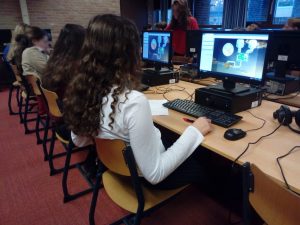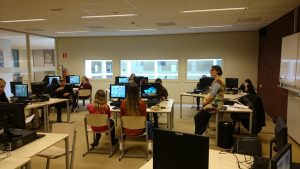We tested Food Chain Farm for the 3rd time in a classroom setting, with great results. So, how does that actually work in practice?

We use a modified version of the game. The first three “levels” are really just simulations. Students have to watch clouds of oxygen and carbon dioxide move between farm animals and answer about 20 questions on paper. Starting with a questionnaire might seem like a boring way to present a game, but it works well. Not all students are natural gamers, and this way they can think about biology before they have to think about which buttons to click.
The first few questions are extremely simple and are designed to make the students just observe what is happening on the screen:
Question: Which two resources are produced by the tree? (Answer: Oxygen and Apples)
Further on, it gets a bit tougher and students are supposed to link what they see with what they’ve learned before.
Question: Which process takes place in the tree (Answer: Photosynthesis)
Question: which cycle is simulated in this game. The carbon cycle, or the nitrogen cycle? (Answer: the carbon cycle)
But then we get to the more interesting part. Further questions do not have a single simple answer. They are designed to make the students think critically, and are a great starting point for classroom discussion.
Question: the tree converts inorganic substances into food, which the cow consumes and converts again into milk and inorganic substances. However after a while, the truck is full of milk and the cycle stops. Why does it stop? (Answer: If milk stays in the truck, then resources are taken away from the cycle. The cycle is actually incomplete, and must break down eventually)
After the questionnaire is done (after half an hour), students are free to play the regular game as far as they can get. They continue to play and build at their own pace. For an extra challenge, all scores are tracked and projected on a central screen.
This is a game is about concepts like photosynthesis, carbon cycle, trophic levels, producers, consumers, herbivores, carnivores, assimilation, dissimilation, food, and energy. But the game doesn’t explain these concepts. I wouldn’t recommend giving the game to new arrivals without instruction, and expect them to be able to take a biology test afterwards. What the game does do very well however, is use what was already taught, and reinforce it, visualize it, provide a fresh perspective on it. The novel presentation keeps students engaged.
I’m looking for more volunteers to test the game in a biology classroom. After three tries I’m very confident that I can provide something that is both engaging and educational. The question list can be adjusted to the level of the students to a very large extent. If you are a biology teacher, or know one, please leave a comment or send me a tweet.
Do you just want to play the game? Food Chain Farm can be downloaded here. Version 0.2 is out now and 0.3 is coming soon!


